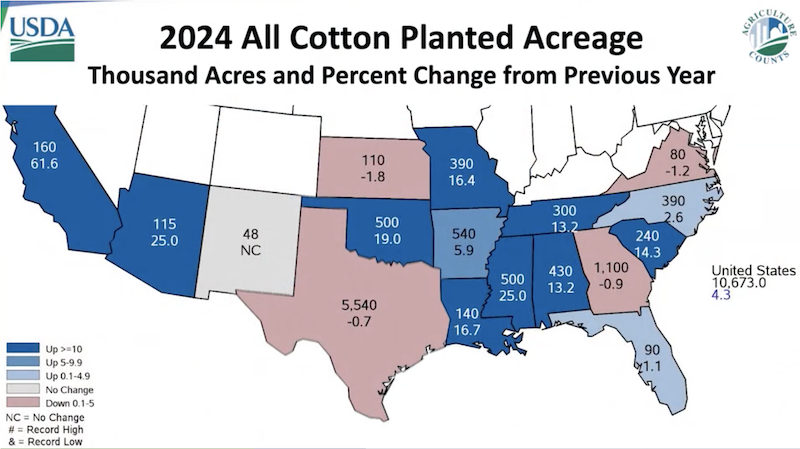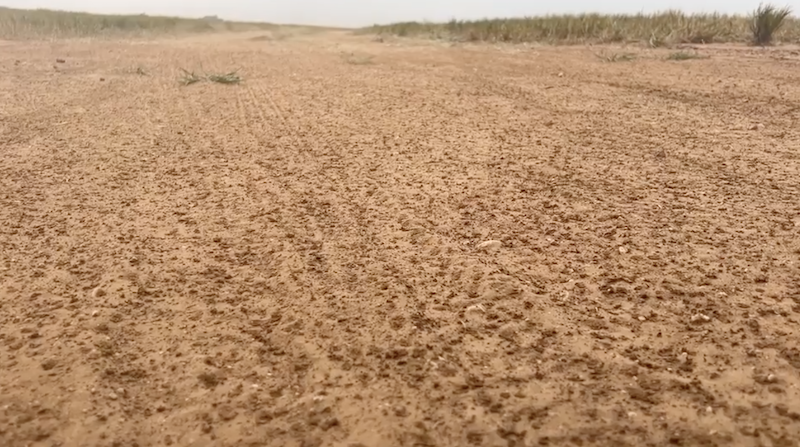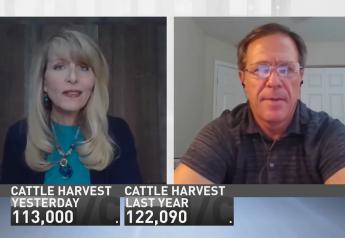Growing a Crop This Year is Crucial for Drought-Stricken Texas Farmers, 2024 is Now Make or Break For Many
U.S. Farm Report 04/06/24 - Farm Journal Report
Glimpses of green sprouting in fields across West Texas, are also producing signs of hope as any soil moisture in this area of the country is cherished.
“Compared to the last two years, we're a little bit ahead of where we were, this time of year, as far as winter moisture,” says Rex Kennedy, who farms around Lubbock, Texas.
The area received much needed rain last week, which is a relief for Kennedy and other area farmers. High winds the past few weeks had zapped the little soil moisture they had, but it's still better than last year when high winds ravaged the area, killing off the winter wheat.
“We’re in need of some good springtime rains and planting rains, but we always are,” Kennedy says.

Kennedy farms around 10,000 acres in a partnership with his brother-in-law, and 8,000 of that is dryland. Last year, they didn’t have a dryland crop to harvest.
This year, the moisture situation is better, but they had been banking on better moisture this winter. El Niño typically brings bouts of snow for farmers in Texas. This year, they didn’t catch any of that.
“January was a little bit above average, March has been above average, but you're talking about, on our farms, what we've averaged is about six-tenths to eight -tenths of an inch,” Kennedy says. “Now that's above average, but it's certainly not as much as we'd like.”
Still, in this area, cotton is the core crop, and Kennedy says they are growing slightly more cotton in 2024.
“My operation, I have all cotton equipment,” he says. “I'm not really set up for grains. Now, if the prices were to be dramatically different, with cotton hovering around 80¢, yes, I would look for something different. But right now, and like always in West Texas, cotton is king."
The 2024 Cotton Planting Picture
USDA’s Prospective Plantings Report released March 28 showed a slight decline in cotton acres for 2024. Nationwide, USDA thinks cotton acres could be up 4% this year.
“I don't think anybody's surprised about the number of cotton acres. What I think what has happened over time is, you know, in our area, or in the south, the corn-cotton ratio has trended in favor of cotton, mostly most of the winter and into the spring,” says Darren Hudson, professor and the Larry Combest Endowed Chair for Agricultural Competitiveness at Texas Tech University. “Everybody was anticipating a few more acres, I think, being planted than the 10.7 million all acres forecast by USDA. Maybe it's an underestimate, but not by much.”

Hudson is an agricultural economist with Texas Tech University who focuses heavily on cotton. He says for 2024, the supply story hinges on abandonment.
“If we had a reasonable summer, sort of normal weather kind of pattern, you could see a pretty sizable crop, just based on you know, the number of acres that get planted,” Hudson says. “With the forecasted La Niña during the summer, that’s not favorable to cotton production.”
The Fallout From Two Consecutive Years of Devastating Drought
Farmers in this area have already faced two consecutive years of drought. Another dry summer would be devastating.
“Crop insurance helps smooth a bit for producers, but only 65% of expected revenue, so it's certainly not going to save them from losing money,” Hudson says. “I think a lot of producers are sort of upside down on the production loans. They've been refinancing, trying to roll that forward. And the banks have been working with them for now, but certainly that's a risk to the banks, too.”
The farm financial situation is already a challenge in West Texas and the Panhandle. The drought took its toll on cotton production and the financial picture, and as Hudson points out, many farmers weren’t able to completely cover their operating loans from last year.
“It's the younger farmers that are more leveraged, that are really feeling that pinch. And that's the group that we least want to see, you know, get out of agriculture,” Hudson says.

The situation is something Plains Cotton Growers CEO Kody Bessent is also concerned about. He says the financial hardship is happening to farmers of all ages.
“We've lost cotton farmers be it young or old; we've had older producers that have exacerbated a lot of their long-term financial income, to the point that they just can't simply sustain that,” Bessent explains. “We've had younger producers, because it's such a difficult industry to get into, especially if you don't have family or friends to help you segue into the industry, that it's very difficult to get your footing and survive if you don't at least make a decent crop and are able to weather some of the financial risks that has bestowed upon the industry.”
The fallout from the drought isn’t just unfolding across farms, according to Bessent, it’s also happening with crucial infrastructure like cotton gins.
“We saw some infrastructure, be it gins or other downstream related segments, completely go out of business, which we're very cautious and very empathetic to that, because in many instances, when a cotton gin by example goes offline, it's very difficult, if not impossible, for it to come back up,” he says.
A Crucial Year for Cotton Farmers
How essential is it for cotton farmers here to not just break even, but make a profit this year? Bessent says it’s huge.
“There's a lot of volatility, a lot of financial duress in the marketplace coming in out of our second year,” he says. “Third year is really difficult for the industry to survive, be it a producer or downstream segments. So, we've got to make a crop. This will make or break an individual for the most part.”
It’s not just concerns about making a crop but also the price of new crop cotton.
“Right now, cotton prices are hovering around 80¢ to 85¢, and that is an absolute must,” Kennedy says.
“If you had told me five or 10 years ago that 82¢ cotton would not be profitable, I probably would have laughed at you. But today, that's pretty close to the breakeven,” Hudson says.

As Kennedy and other area farmers prep fields to plant, the risk is high.
“When you talk about cotton, for example, anywhere from 40% to 60% of the price or the cost of production is in the ground when you put the seed in, so, a loss at that point is pretty substantial that insurance is just not going to cover living expenses and everything else,” Hudson says.
“My main concern coming up, I guess, No. 1 would be timely rains, but once again, No. 2 these input cost with no farm program,” says Kennedy. “It's going to be hard to make this pencil out without a drastic change in our foreign policy and the economy adjusting to where we can get some of these input costs where they're not so high.”
From increased costs, to barely break-even prices for the cotton planted this spring, West Texas farmers continue to find new ways to weather the storm. And that’s what it’s going to take to save a vital piece of the area’s economy and livelihood.







